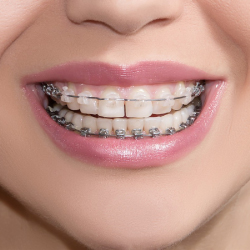
Self-ligating brackets are also referred to as Smart Brackets or Damon Braces. They have been in existence since the early 1930s, but they didn’t become a sought-after item until about 10 years ago. The brackets can be clear, ceramic or metal, but their appearance blends in with the teeth more than the classic braces. You can also choose between active or passive brackets.
How Do Self-Ligating Braces Work?
Because there are fewer wires used for self-ligating braces, the movement of the teeth is subtle, with less soreness. The ‘trap door’ made on the brackets allows the archwire to move smoothly through the brackets while the teeth are shifting. This also keeps the wire in place as it’s moving, so there is no need to use ties or rubber bands to ensure the wire moves along the brackets. This system reduces friction, so there is less need for bracket maintenance.
Before installing self-ligating braces, the dentist will examine your teeth to determine if this option is suitable for your type of dental issue. If the price of these braces is affordable for you, then your dentist will measure your teeth for the right fit. Before you make the final decision to get self-ligating braces, the following information should help you make a more informed decision.
Advantages of Self-Ligating Braces
One of the biggest contributors to the current popularity of self-ligating braces is its overall design. All types of braces will have wires and brackets. However, instead of the archwire being secured by rubber bands (like with the classic braces), the archwire is maintained by the actual bracket using a spring-loaded door. This difference in design has also contributed to the many benefits of using self-ligating braces:
- Quicker Installation: thanks to having no elastic wound around each bracket, the installation time is reduced.
- Decreased Overall Soreness: because it takes less force to move teeth and the brackets are much thinner than traditional brackets, these braces don’t cause as much mouth soreness.
- Decreases Wear Time: depending on the nature of the dental issue, you can reduce your time of wearing braces by as much as six months.
- Decreased Follow-up Appointments: the advanced technology of self-ligating braces requires less maintenance to adjust them, which translates into fewer follow-up appointments. The tension remains constant, so the need for frequent follow-ups to adjust the brackets is not needed.
- Easier to Maintain: If you are not going to invest lots of time in cleaning your braces at home, self-ligating braces are perfect since they trap less food and create less plaque build-up.
Disadvantages of Self-Ligating Braces
- More Expensive: advanced technology always comes with a higher price tag.
- Not 100% Invisible: You can get clear brackets, but the wire going across each tooth will be seen regardless.
- Increased Adjustment Soreness: The mouth soreness caused from the adjustments made to the brackets when being installed and during each visit to adjust brackets will last a longer number of days than it would with more traditional braces.
Book your appointment online
See our clinician availability and book a slot that works best around your schedule. Only Private appointments are bookable.
Book your appointment online
See our clinician availability and book a slot that works best around your schedule. Only Private appointments are bookable.
